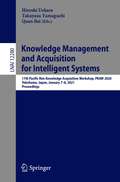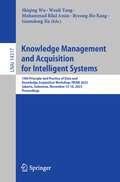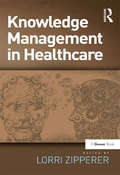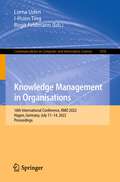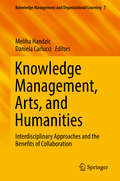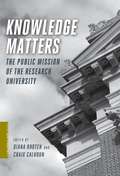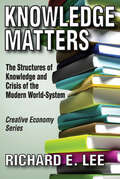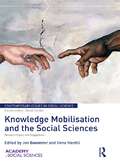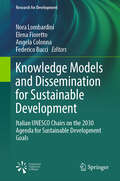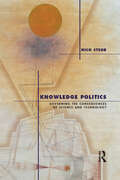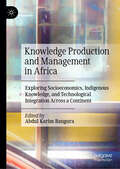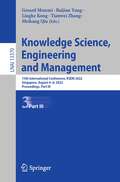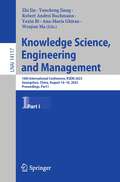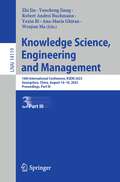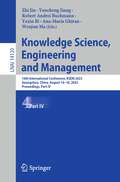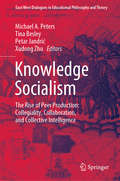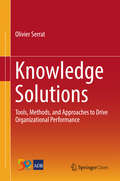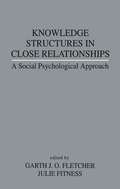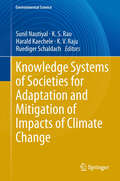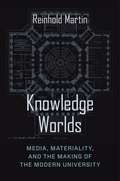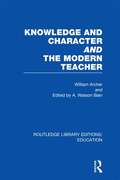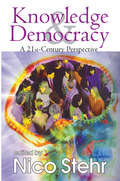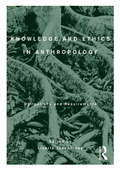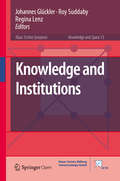- Table View
- List View
Knowledge Management and Acquisition for Intelligent Systems: 17th Pacific Rim Knowledge Acquisition Workshop, PKAW 2020, Yokohama, Japan, January 7–8, 2021, Proceedings (Lecture Notes in Computer Science #12280)
by Quan Bai Hiroshi Uehara Takayasu YamaguchiThis book constitutes the proceedings of the 17th International Workshop on Knowledge Management and Acquisition for Intelligent Systems, PKAW 2020, held in Yokohama, Japan, in January 2021. The 10 full papers and 5 short papers included in this volume were carefully reviewed and selected from 28 initial submissions. PKAW primarily focuses on the multidisciplinary approach of the human-driven and data-driven knowledge acquisition, which is the key concept that has remained unchanged since the workshop has been established.
Knowledge Management and Acquisition for Intelligent Systems: 19th Principle and Practice of Data and Knowledge Acquisition Workshop, PKAW 2023, Jakarta, Indonesia, November 15-16, 2023, Proceedings (Lecture Notes in Computer Science #14317)
by Guandong Xu Byeong-Ho Kang Shiqing Wu Wenli Yang Muhammad Bilal AminThis book constitutes the refereed proceedings of the 19th Principle and Practice of Data and Knowledge Acquisition Workshop, PKAW 2023, held in conjunction with the 20th Pacific Rim International Conference on Artificial Intelligence (PRICAI 2023), in November 2023, in Jakarta, Indonesia. The 9 full papers and 2 short papers included in this volume were carefully reviewed and selected from 28 initial submissions. They are organized in the topical section such as machine learning, natural language processing, and intelligent systems.
Knowledge Management in Healthcare
by Lorri ZippererKnowledge management goes beyond data and information capture in computerized health records and ordering systems; it seeks to leverage the experiences of all who interact in healthcare to enhance care delivery, teamwork, and organizational learning. Knowledge management - if envisioned thoughtfully - takes a systemic approach to implementation that includes the embodiment of a learning culture. Knowledge is then used to support that culture and the knowledge workers within it to encourage them to share what they know, thusly enabling their peers, their organizations and ultimately their patients to benefit from their experience to proactively dismantle hierarchy and encourage sharing about what works, and what doesn’t to focus efforts on improvement. Knowledge Management in Healthcare draws on relevant business, clinical and health administration literature plus the analysis of discussions with a variety of clinical, administrative, leadership, patient and information experts. The result is a book that will inform thinking on knowledge access needs to mitigate potential failures, design lasting improvements and support the sharing of what is known to enable work towards attaining high reliability. It can be used as a general tool for leaders and individuals wishing to devise and implement a knowledge-sharing culture in their institution, design innovative activities supporting transparency and communication to strengthen existing programs intended to enhance knowledge sharing behaviours and contribute to high quality, safe care.
Knowledge Management in Organisations: 16th International Conference, KMO 2022, Hagen, Germany, July 11–14, 2022, Proceedings (Communications in Computer and Information Science #1593)
by Lorna Uden I-Hsien Ting Birgit FeldmannThis book contains the refereed proceedings of the 16th International Conference on Knowledge Management in Organizations, KMO 2022, held in Hagen, Germany, in July 2022. The 24 full papers and 5 short papers accepted for KMO 2022 were selected from 61 submissions and are organized in topical sections on: knowledge transfer and sharing; knowledge and organization; knowledge and service innovation; industry 4.0; information and knowledge systems; intelligent science; AI and new trends in KM.
Knowledge Management, Arts, and Humanities: Interdisciplinary Approaches and the Benefits of Collaboration (Knowledge Management and Organizational Learning #7)
by Meliha Handzic Daniela CarlucciThis book presents a series of studies that demonstrate the value of interactions between knowledge management with the arts and humanities. The carefully compiled chapters show, on the one hand, how traditional methods from the arts and humanities – e.g. theatrical improvisation, clay modelling, theory of aesthetics – can be used to enhance knowledge creation and evolution. On the other, the chapters discuss knowledge management models and practices such as virtual knowledge space (BA) design, social networking and knowledge sharing, data mining and knowledge discovery tools. The book also demonstrates how these practices can yield valuable benefits in terms of organizing and analyzing big arts and humanities data in a digital environment.
Knowledge Matters: The Public Mission of the Research University (A Columbia / SSRC Book)
by Craig Calhoun Diana RhotenHigher education can be a vital public good, providing opportunities for students, informed citizens for democracy, and knowledge to improve the human condition. Yet public investment in universities is widely being cut, often because public purposes are neglected while private benefits dominate. In this collection, international scholars confront the realities of higher education and the future of its public and private agenda. Their perspectives illuminate the trajectory of education in the twenty-first century and the continuing importance of the university's public mission. Reporting from Asia, Africa, Europe, Latin America, and North America, these scholars look at the different ways universities struggle to serve public and private agendas. Contributors examine the implications of changes in funding sources as well as amounts, different administrative and policy decisions, and the significance of various approaches to assessment and evaluation. They ask whether wider student access has in fact resulted in social mobility, whether more scientific research can be treated as an open-access resource, how changes in academic publishing change access to knowledge, and whether universities get full value from research sold to private corporations. At the same time, these chapters capture the confusion in the university sector over explaining academic work to a broader public and prioritizing its multiple purposes. Authors examine these practical challenges and the implications of different approaches in different contexts.
Knowledge Matters: The Structures of Knowledge and Crisis of the Modern World-System (Creative Economy & Innovation Culture)
by Richard E. LeeEconomic changes and political changes which emerged with the modern capitalist world-economy were accompanied in the sociocultural domain by changes in the structures of knowledge. These included the hierarchical separation of the realm of facts from that of values, institutionalized as a division between the sciences and the humanities. The social sciences responded to contradictions inherent in this structure over the nineteenth century in producing knowledge on which policy decisions could be based. The problems of the contemporary period indicate we are in a long-term, structural crisis. Nowhere is this more apparent than in the theoretical frameworks and methodological approaches through which social analysts and observers alike seek to understand the world. Since the 1960s, developments in the field of knowledge, especially two movements complexity studies in the natural sciences and cultural studies in the humanities have contested the naturalized, essentialist boundaries separating the sciences, the social sciences and the humanities. The primary rationale for this work is to recognize the inseparable whole composed of the material structures of the world and the structures of knowledge that govern what actions may be deemed legitimate and effective. 'Knowledge Matters' discusses what actions will actually be undertaken by social agents, and what such an approach means for an analysis of the present situation in terms of imagining and evaluating possible futures.
Knowledge Mobilisation and the Social Sciences: Research Impact and Engagement (Contemporary Issues in Social Science)
by Irene Hardill Jon BannisterThe essays presented in this volume examine knowledge mobilisation and its relation to research impact and engagement. The social sciences matter because they can help us to understand and address the complex challenges confronting society. This is particularly true in an era of significant downward pressure on public expenditure, a consequence of the global fiscal crisis, when there is a striking need to ensure that policies are demonstrably effective and efficient. The impact agenda in the UK, reflected in parallel global debates, actively encourages the social sciences to make and demonstrate a difference; to justify and protect social science funding. This volume shows how knowledge mobilisation can be thought of systematically as a process, encompassing engagement, leading to the co-production and channelling of knowledge to make a difference in the economy and society. This book was originally published as a special issue of Contemporary Social Science.
Knowledge Models and Dissemination for Sustainable Development: Italian UNESCO Chairs on the 2030 Agenda for Sustainable Development Goals (Research for Development)
by Nora Lombardini Elena Fioretto Angela Colonna Federico BucciThis book delves into the invaluable contributions made by the Italian UNESCO Chairs toward addressing the intricate and pressing global challenges of our era. Established within the UNITWIN/UNESCO Chairs program initiated by UNESCO in 1992, these Chairs serve as vital links between the realms of academic research and civil society. They offer a conduit for disseminating knowledge, thereby advancing the objectives of global development. By facilitating the transfer and adoption of scientific methodologies through intellectual collaboration, they strive to enhance the sustainability and resilience of both individual communities and society at large. Through a series of dialogues, the Italian UNESCO Chairs critically examine the challenges inherent in this mission, the objectives they aim to achieve, the strategies employed in scientific research, and the development of novel areas of study. They approach these endeavors with a conscientious and responsible mindset, recognizing them as essential responses to the multifaceted issues arising in our rapidly evolving world. The contributions put forth by the Italian UNESCO Chairs serve as practical tools for the implementation of the 17 Sustainable Development Goals, making them relevant to various stakeholders. These include not only citizens, scholars, public and private institutions, research centers, and administrators but also anyone with an interest in tackling the challenges of sustainable development in our everyday lives.
Knowledge Politics: Governing the Consequences of Science and Technology (Routledge Library Editions: Social Theory Ser.)
by Nico StehrThis book argues that new technologies and society's response to them have created a relatively new phenomenon, "knowledge politics." Nico Stehr describes Western society's response to a host of new technologies developed only since the 1970s, including genetic experiments, test-tube human conception, recombinant DNA, and embryonic stem cells; genetically engineered foods; neurogenetics and genetic engineering; and reproductive cloning and the reconstruction of the human ancestral genome. He looks also at the prospective fusion of nanotechnology, biotechnology, information technology, transgenic human engineering, and cognitive science whose products may, as its boosters claim, some day cure disease, slow the aging process, eliminate pollution, and generally enhance human performance. Knowledge Politics shows how human civilization has reached a new era of concern about the life-altering potentials of new technologies. Concerns about the societal consequences of an unfettered expansion of (natural) scientific knowledge are being raised more urgently and are moving to the center of disputes in society-- and thus to the top of the political agenda. Stehr explains the ramifications of knowledge politics and the approaches society could take to resolve difficult questions and conflicts over present and future scientific innovation.
Knowledge Production and Management in Africa: Exploring Socioeconomics, Indigenous Knowledge, and Technological Integration Across a Continent
by Abdul Karim BanguraThis contributed volume explores knowledge production and management across diverse African contexts, integrating indigenous perspectives with modern technological advancements. It addresses the intersection of cultural, socioeconomic, and technological factors, offering readers a thorough understanding of how these elements shape knowledge systems in Africa. Structured into five key sections—technology, pedagogy and curricula, business and ecology, culture and community, and human relationships—the book presents a cohesive framework guiding readers through various domains of knowledge production. Each chapter examines specific themes, from AI&’s moral standing and mobile technologies in agriculture to digital transformation in education and the role of performing arts in cultural orientation. The chapters are authored by experts who provide empirical research, case studies, and theoretical analyses, ensuring a rich and diverse exploration of topics. By challenging conventional paradigms and advocating for context-specific approaches, the book highlights the resilience and innovation inherent in African knowledge practices. Readers will gain a deep understanding of the multifaceted nature of knowledge production in Africa. The book highlights culturally-responsive cognitive schemas, the impact of digital technologies on education and business, and the role of indigenous knowledge in sustainable development. Readers will walk away from the book understanding inclusive and effective knowledge management practices, and they will have an enhanced appreciation for the unique contributions of African knowledge systems to global discourses.
Knowledge Science, Engineering and Management: 15th International Conference, KSEM 2022, Singapore, August 6–8, 2022, Proceedings, Part III (Lecture Notes in Computer Science #13370)
by Meikang Qiu Linghe Kong Gerard Memmi Baijian Yang Tianwei ZhangThe three-volume sets constitute the refereed proceedings of the 15th International Conference on Knowledge Science, Engineering and Management, KSEM 2022, held in Singapore, during August 6–8, 2022. The 169 full papers presented in these proceedings were carefully reviewed and selected from 498 submissions. The papers are organized in the following topical sections:Volume I:Knowledge Science with Learning and AI (KSLA)Volume II:Knowledge Engineering Research and Applications (KERA)Volume III:Knowledge Management with Optimization and Security (KMOS)
Knowledge Science, Engineering and Management: 16th International Conference, KSEM 2023, Guangzhou, China, August 16–18, 2023, Proceedings, Part I (Lecture Notes in Computer Science #14117)
by Yaxin Bi Zhi Jin Robert Andrei Buchmann Wenjun Ma Yuncheng Jiang Ana-Maria GhiranThis volume set constitutes the refereed proceedings of the 16th International Conference on Knowledge Science, Engineering and Management, KSEM 2023, which was held in Guangzhou, China, during August 16–18, 2023. The 114 full papers and 30 short papers included in this book were carefully reviewed and selected from 395 submissions. They were organized in topical sections as follows: knowledge science with learning and AI; knowledge engineering research and applications; knowledge management systems; and emerging technologies for knowledge science, engineering and management.
Knowledge Science, Engineering and Management: 16th International Conference, KSEM 2023, Guangzhou, China, August 16–18, 2023, Proceedings, Part III (Lecture Notes in Computer Science #14119)
by Yaxin Bi Zhi Jin Robert Andrei Buchmann Wenjun Ma Yuncheng Jiang Ana-Maria GhiranThis volume set constitutes the refereed proceedings of the 16th International Conference on Knowledge Science, Engineering and Management, KSEM 2023, which was held in Guangzhou, China, during August 16–18, 2023. The 114 full papers and 30 short papers included in this book were carefully reviewed and selected from 395 submissions. They were organized in topical sections as follows: knowledge science with learning and AI; knowledge engineering research and applications; knowledge management systems; and emerging technologies for knowledge science, engineering and management.
Knowledge Science, Engineering and Management: 16th International Conference, KSEM 2023, Guangzhou, China, August 16–18, 2023, Proceedings, Part IV (Lecture Notes in Computer Science #14120)
by Yaxin Bi Zhi Jin Robert Andrei Buchmann Wenjun Ma Yuncheng Jiang Ana-Maria GhiranThis volume set constitutes the refereed proceedings of the 16th International Conference on Knowledge Science, Engineering and Management, KSEM 2023, which was held in Guangzhou, China, during August 16–18, 2023. The 114 full papers and 30 short papers included in this book were carefully reviewed and selected from 395 submissions. They were organized in topical sections as follows: knowledge science with learning and AI; knowledge engineering research and applications; knowledge management systems; and emerging technologies for knowledge science, engineering and management.
Knowledge Socialism: The Rise of Peer Production: Collegiality, Collaboration, and Collective Intelligence (East-West Dialogues in Educational Philosophy and Theory)
by Michael A. Peters Xudong Zhu Petar Jandrić Tina BesleyThis is the first collection focusing on knowledge socialism, a particularly apt term used to describe a Chinese socialist mode of production and socialist approach to development and modernity based around the rise of peer production, new forms of collaboration and collective intelligence. Making the case for knowledge socialism, the book is intended for students, teacher, scholars and policy theorists in the field of knowledge economy.
Knowledge Solutions
by Olivier SerratThis book is open access under a CC BY-NC 3. 0 IGO license. This book comprehensively covers topics in knowledge management and competence in strategy development, management techniques, collaboration mechanisms, knowledge sharing and learning, as well as knowledge capture and storage. Presented in accessible "chunks," it includes more than 120 topics that are essential to high-performance organizations. The extensive use of quotes by respected experts juxtaposed with relevant research to counterpoint or lend weight to key concepts; "cheat sheets" that simplify access and reference to individual articles; as well as the grouping of many of these topics under recurrent themes make this book unique. In addition, it provides scalable tried-and-tested tools, method and approaches for improved organizational effectiveness. The research included is particularly useful to knowledge workers engaged in executive leadership; research, analysis and advice; and corporate management and administration. It is a valuable resource for those working in the public, private and third sectors, both in industrialized and developing countries.
Knowledge Structures in Close Relationships: A Social Psychological Approach
by Garth J. O. Fletcher Julie FitnessThirty-three of the top scholars in this fast moving domain present a picture of work at the cusp in social psychology -- work that deals with cognition and affect in close relationships. The present volume contains a wealth of research findings and influential theoretical accounts that spring as much from indigenous work in the close relationship field as from purebred social cognition. The chapters introduce theories and research programs concerned with the role of individual and couple differences in close relationship knowledge structures. They deal with the role of emotion and affect in close relationships. And they discuss the function of cognition and knowledge structures in relation to the developmental course of close relationships. Each section is accompanied by a critical review written by an expert in the field. This volume is a must for any close relationship scholar interested in the latest research and theorizing about close relationships that adopt a social psychological perspective. It will also be of interest to scholars and students working in clinical psychology, social cognition, communication, individual differences, and family studies.
Knowledge Systems of Societies for Adaptation and Mitigation of Impacts of Climate Change
by K. V. Raju Sunil Nautiyal Ruediger Schaldach Harald Kaechele K. S. RaoClimate change is broadly recognized as a key environmental issue affecting social and ecological systems worldwide. At the Cancun summit of the United Nations Framework Convention on Climate Change's 16th Conference, the parties jointly agreed that the vulnerable groups particularly in developing countries and whose livelihood is based on land use practices are the most common victims as in most cases their activities are shaped by the climate. Therefore, solving the climate dilemma through mitigation processes and scientific research is an ethical concern. Thus combining the knowledge systems of the societies and scientific evidences can greatly assist in the creation of coping mechanisms for sustainable development in a situation of changing climate. International Humboldt Kolleg focusing on "knowledge systems of societies and Climate Change" was organized at ISEC. This event was of unique importance, as the year 2011-12 was celebrated as the 60th Anniversary of Diplomatic Relations between India and Germany with the motto "Germany and India - Infinite Opportunities." This volume is the outcome of the papers presented during the IHK 2011 at ISEC, India.
Knowledge Translation in Context
by Anne Marshall Bonnie Leadbeater Elizabeth M. BanisterThe main goal of knowledge translation (KT) is to ensure that diverse communities benefit from academic research results through improved social and health outcomes. But despite growing interest in researcher-user collaborations, little is known about what makes or breaks these types of relationships. Knowledge Translation in Context is an essential tool for researchers to learn how to be effective partners in the KT process.Drawing on expertise and studies from across the globe, Elizabeth Banister, Bonnie Leadbeater, and Anne Marshall outline a variety of perspectives on KT processes. Case studies outline the uses of KT in many contexts, including community, policy, Indigenous, and non-profit organizations. While recognizing the specificity of each situation, Knowledge Translation in Context highlights the most important elements that have led KT to succeed (or fail) as a dynamic, multidirectional process.
Knowledge Worlds: Media, Materiality, and the Making of the Modern University
by Reinhold MartinWhat do the technical practices, procedures, and systems that have shaped institutions of higher learning in the United States, from the Ivy League and women’s colleges to historically black colleges and land-grant universities, teach us about the production and distribution of knowledge? Addressing media theory, architectural history, and the history of academia, Knowledge Worlds reconceives the university as a media complex comprising a network of infrastructures and operations through which knowledge is made, conveyed, and withheld.Reinhold Martin argues that the material infrastructures of the modern university—the architecture of academic buildings, the configuration of seminar tables, the organization of campus plans—reveal the ways in which knowledge is created and reproduced in different kinds of institutions. He reconstructs changes in aesthetic strategies, pedagogical techniques, and political economy to show how the boundaries that govern higher education have shifted over the past two centuries. From colleges chartered as rights-bearing corporations to research universities conceived as knowledge factories, educating some has always depended upon excluding others. Knowledge Worlds shows how the division of intellectual labor was redrawn as new students entered, expertise circulated, science repurposed old myths, and humanists cultivated new forms of social and intellectual capital. Combining histories of architecture, technology, knowledge, and institutions into a critical media history, Martin traces the uneven movement in the academy from liberal to neoliberal reason.
Knowledge and Character bound with The Modern Teacher (Routledge Library Editions: Education)
by William ArcherWritten before, but published after The First World War, this volume’s plea for a national system of education which will produce a nation of prosperous, morally fulfilled people able to live at peace with other nations is doubly poignant given the sacrifice of the ‘lost generation’. However, the author also sees the horror of the War as an opportunity to change human destiny through education, an opportunity to abandon the narrow system of education in favour of one which will ‘bring education in touch with life’ and provide Britain with the intellectual and moral efficiency necessary to steer her through the following turbulent years of the twentieth century. Covering the core subjects of the English school curriculum in the early twentieth century the chapters in The Modern Teacher, if somewhat utopian, describe best practice in teaching of the particular subject and suggest possible improvements. One chapter also discusses the importance of the relatively new subject of citizenship, as well as the moral education of pupils.
Knowledge and Democracy: A 21st Century Perspective
by Nico StehrThe relationship of knowledge and liberties in modern societies presents a multitude of fascinating issues that deserve to be explored more systematically. The production of knowledge is dynamic, and the conditions and practice of freedom is undergoing transformation. These changes ensure that the linkages between liberty and knowledge are always subject to changes. In the past, the connection between scientific knowledge, democracy, and emancipation seemed self-evident. More recently, the close linkage between democracy and knowledge has been viewed with skepticism. This volume explores the relationship between knowledge and democracy, Do they support each other, do they mutually depend on each other, or are they perhaps even in conflict with each other? Does knowledge increase the freedom to act? If additional knowledge contributes to individual and social well being, does it also enhance freedoms? Knowledge and Democracy focuses on the interpenetration of knowledge, freedom and democracy, and does so from various perspectives, theoretical as well as practical. Modern societies are transforming themselves into knowledge societies. This has a fundamental impact on political systems and the relationship of citizens to large social institutions. The contributors to this book systemically explore whether, and in what ways, these modern-day changes and developments are connected to expansion of the capacities of individual citizens to act. They focus on the interrelation of democracy and knowledge, and the role of democratic institutions, as well as on the knowledge and social conduct of actors within democratic institutions. In the process of investigation, they arrive at a new platform for future research and theory, one that is sensitive to present-day societal conflicts, cleavages, and transformations generated by new knowledge. In this way, this volume will attract the interest of political scientists, sociologists, economists and students within various disciplines.
Knowledge and Ethics in Anthropology: Obligations and Requirements (Criminal Practice Ser. #31)
by Lisette JosephidesInspired by the work of world-renowned anthropologist Marilyn Strathern, this collection of essays features contributions from a range of internationally recognized scholars – including Strathern herself – which examine a range of methodologies and approaches to the anthropology of knowledge.The book investigates the production of knowledge through a variety of themes, centered on the question of the researcher’s obligations and the requirements of knowledge. These range from the obligation to connect with local culture and existing anthropological knowledge, to the need to draw conclusions and circulate what has been learned. Taking up themes that are relevant for anthropology as a whole – particularly the topic of knowledge and the ethics of knowing others, as well as the notion of the local in a global world – Knowledge and Ethics in Anthropology is key reading for students and scholars alike. A thorough introduction to the key concepts and terms used in Strathern’s work is provided, making this a fantastic resource for anyone encountering her work for the first time.
Knowledge and Institutions (Knowledge and Space #13)
by Roy Suddaby Johannes Glückler Regina LenzThis open access book bridges the disciplinary boundaries within the social sciences to explore the role of social institutions in shaping geographical contexts, and in creating new knowledge. It includes theorizations as well as original empirical case studies on the emergence, maintenance and change of institutions as well as on their constraining and enabling effects on innovation, entrepreneurship, art and cultural heritage, often at regional scales across Europe and North America. Rooted in the disciplines of management and organization studies, sociology, geography, political science, and economics the contributors all take comprehensive approaches to carve out the specific contextuality of institutions as well as their impact on societal outcomes. Not only does this book offer detailed insights into current debates in institutional theory, it also provides background for scholars, students, and professionals at the intersection between regional development, policy-making, and regulation.
